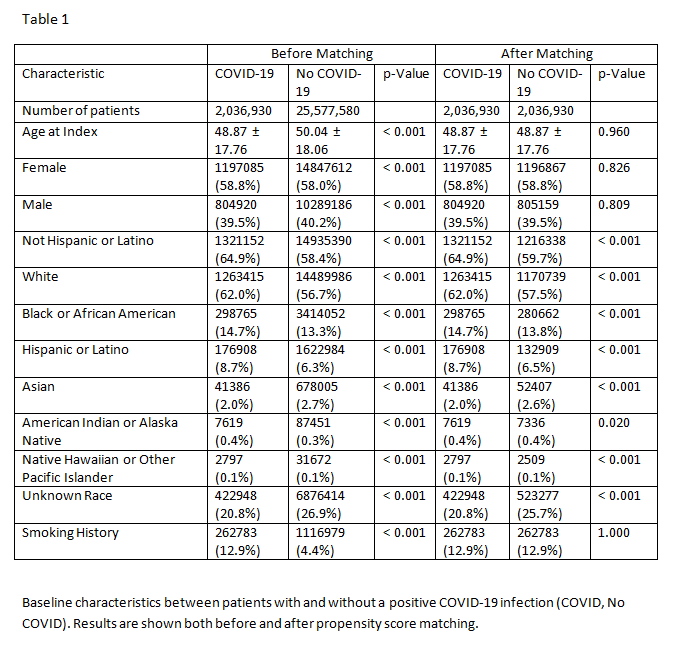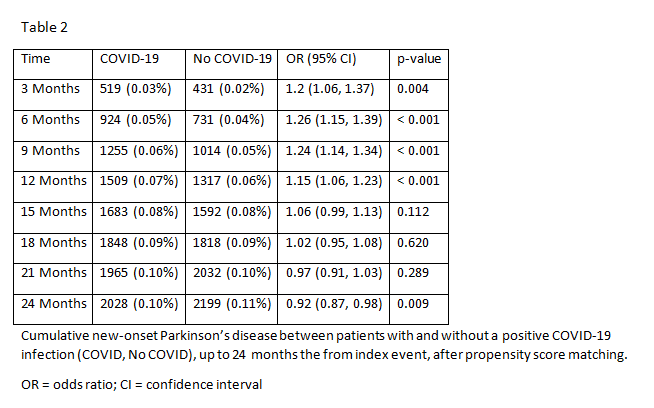Category: Epidemiology
Objective: We aimed to utilize a large healthcare research network to determine the risk of developing Parkinson disease following COVID-19 infection compared individuals without COVID-19 infection.
Background: Acute coronavirus disease 19 (COVID-19) infection is known to manifest with neurological symptoms (1). Patients with prior COVID-19 infection are at an increased risk of developing psychiatric and neurologic comorbidities, including dementia, parkinsonism, anxiety, and psychosis (2, 3). Therefore there is reason to believe that COVID-19 infection may raise the incidence of subsequent development of Parkinson disease (PD). To our knowledge, no study to date has used a large data set in the United States to ascertain the risk of developing incident PD in patients with history of COVID-19 infection (with or without hospitalization), compared to the risk amongst those without prior COVID-19 infection.
Method: We utilized data from TriNetX electronic health records network which includes 73 healthcare organizations and over 107 million patients. We compared adult patients with and without COVID-19 infection, with health records from January 1, 2020 through July 26, 2022, to determine the relative risk of developing Parkinson disease stratified by 3-month intervals. We used propensity score matching to control for patients’ age, sex, and smoking history.
Results: We collected data on 27,614,510 patients meeting our study criteria: 2,036,930 patients with a positive COVID-19 infection (COVID-19) and 25,577,580 without a positive COVID-19 infection (non-COVID-19). After propensity score matching, age, sex, and smoking history differences became non-significant, with 2,036,930 patients in each cohort (Table 1). After propensity score matching, we found significantly increased odds of new onset Parkinson disease in the COVID-19 cohort at three, six, nine, and twelve months from the index event, with peak odds ratio at six months. After twelve months there is no significant difference between the COVID-19 group and non-COVID-19 group (Table 2).
Conclusion: There may be a transiently increased risk of developing Parkinson disease in the first year following COVID-19 infection, with a progressively diminishing risk for the next year after that.
References: 1. Ousseiran ZH, Fares Y, Chamoun WT. Neurological manifestations of COVID-19: a systematic review and detailed comprehension. Int J Neurosci. 2021 Sep 27:1-16.
2. Rogers JP, Chesney E, Oliver D, Pollak TA, McGuire P, Fusar-Poli P, et al. Psychiatric and neuropsychiatric presentations associated with severe coronavirus infections: a systematic review and meta-analysis with comparison to the COVID-19 pandemic. Lancet Psychiatry. 2020 Jul;7(7):611-27.
3. Taquet M, Geddes JR, Husain M, Luciano S, Harrison PJ. 6-month neurological and psychiatric outcomes in 236 379 survivors of COVID-19: a retrospective cohort study using electronic health records. Lancet Psychiatry. 2021 May;8(5):416-27.
To cite this abstract in AMA style:
A. Wang, J. Perez, S. Gunzler. Frequency of Parkinson disease following COVID-19 infection: a two-year retrospective cohort study [abstract]. Mov Disord. 2023; 38 (suppl 1). https://www.mdsabstracts.org/abstract/frequency-of-parkinson-disease-following-covid-19-infection-a-two-year-retrospective-cohort-study/. Accessed December 15, 2025.« Back to 2023 International Congress
MDS Abstracts - https://www.mdsabstracts.org/abstract/frequency-of-parkinson-disease-following-covid-19-infection-a-two-year-retrospective-cohort-study/


